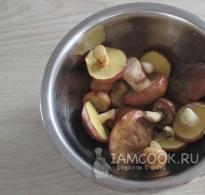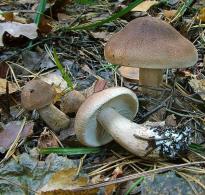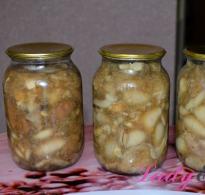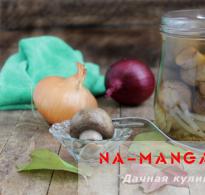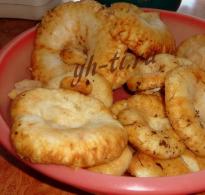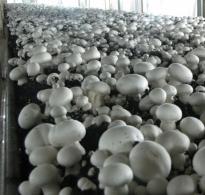Row mushrooms: photo and description, edible and inedible species
Rows of photos and descriptions of which must be studied by everyone who likes to go on a "quiet hunt". In nature, rows are found both edible and poisonous.
Rows got their name from the fact that they grow in long rows or witch circles. The scientific name for the fungus is tricholoma. They are representatives of the ordinary family, the agaric order, the Agaricomycete class, the Basidiomycete division.
Description and differences
Even edible representatives of this species must be carefully cooked before being eaten. However, they are very similar to their poisonous counterparts. Consider the distinctive features of edible and poisonous rows:
- In poisonous species, the caps are even, only white in color and an unpleasant pungent odor emanates from them.
- Edible rows of hats can be different: purple, grey, pink or purple. The legs match the shade of the hat. The plates under the cap are bright yellow, the flesh in the section is the same color as the plates.
- Friendly groups of mushrooms can be found in autumn (September-October) and especially after the first autumn frosts. Their favorite places to germinate are the soil among the moss or the surface of the forest floor.
Varieties edible rows
purple(Lepista nuda)
A mushroom from the representatives of the Ryadovkov family from the genus Lepista. They also call her lepista purple or naked. In the common people, it is sometimes called a titmouse for its lilac-blue color. This mushroom is conditionally edible.
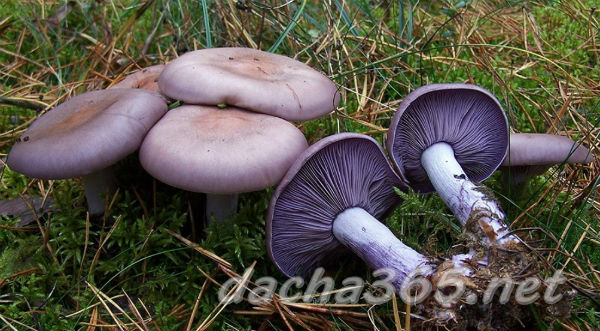
- The hat in diameter can reach 20 cm. Initially, its shape is hemispherical (like a bun), in the process of ripening it becomes flat, and the edges are thin and curved.
- The color of the cap is brown-violet, in the process of growth it becomes lighter, starting from the edges. To the touch it is dense, fleshy and elastic. It is smooth and moist, in places it shines.
- The pulp is firm, thick, has a pleasant taste and smell. The shade is marbled, lilac-blue, which fades over time.
- The plates are thin, often located. Their color varies from bright purple to light purple.
- The leg has the shape of a cylinder, reaches a height of 10 cm, and a diameter of 0.7 to 2.5 cm. Bright purple at the beginning of growth and whitish or pale purple towards the end, its surface is fibrous.
- Purple rowing grows in coniferous forests (less often in mixed forests), in the temperate climate of the Northern Hemisphere (European part of Russia, Siberia). Not whimsical.
- Collection can be carried out from the beginning of September to the end of November, before the onset of the first frost.
- Before using the purple row, it must be boiled for 10-20 minutes.
Important! This mushroom has an inedible counterpart - goat web. It is bitter in taste, has a musty smell and yellow flesh.
Gray(Tricholoma portentosum)
- Grows in groups in coniferous or mixed forests.
- Collection season - September-November.
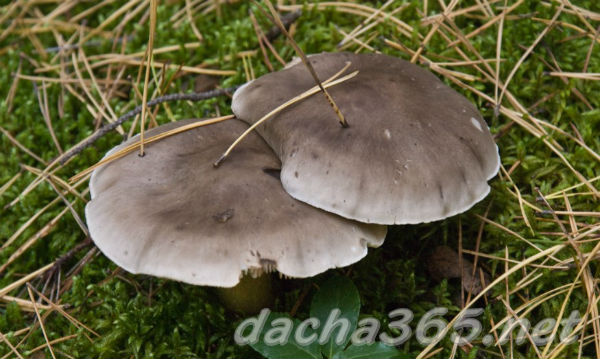
- The cap reaches a diameter of 5-12 cm, sometimes 16 cm. The surface is grayish brown in the center, sometimes with a purple or olive tint, and the edges are light gray or cream. The radial fibers are darker in the middle. Often there is a flat tubercle in the center of the cap.
- The short grayish-yellowish stem reaches 5-12 cm in height and 1-2.5 cm in thickness, thickened at the base, covered with powdery coating at the top.
- The pulp at the beginning of growth is solid, later grooved, dense, has a whitish tint. A powdery smell and taste are inherent in young specimens, and over time, the aroma becomes even pungent. The flesh under the skin of the cap is gray.
- The plates are free or straight and attached with a tooth to the stem. They may be white, cream or gray-yellow, with yellowish spots as they age.
- Mushrooms are edible, but they need to be boiled in two waters to remove the pungent odor. It is better to collect young specimens. cook like this: boiled, fried or salted.
The gray row can be confused with the soap row (Tricholoma saponaceum). It is similar in shape and color, but at a young age. It can be distinguished only by the specific soapy smell of the pulp.
crowded(Lyophyllum decastes)
- It grows in large groups in forests, parks, gardens, lawns, near stumps, on soil rich in humus.
- Collection season - July - October.
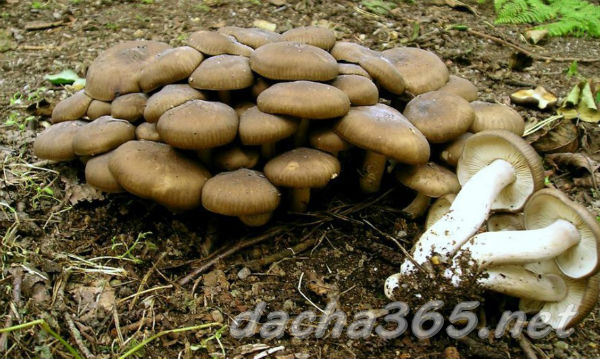
- The hemispherical hat can reach a diameter of up to 4-14 cm, becomes convex as it grows. These mushrooms grow so densely that their bases are sometimes difficult to separate.
- The hat can be brown or gray-brown, the edges are down, wavy. The surface itself is uneven and bumpy. Often a wide tubercle is located in the center.
- The leg reaches a height of 4-10 cm, and a thickness of 6-20 cm, can be bent or compacted. Completely white above, and towards the bottom it can acquire a light gray or gray-brown hue.
- The flesh is white, has a pleasant taste and smell, thickened in the center.
- Narrow plates adherent, often located. They are white or off-white in color.
- Row crowded belongs to category 4 edible mushrooms. Description of preparation: they can be fried, salted or pickled.
Twisted row is similar to poisonous yellowish-gray entoloma (Entoloma lividum). Their similarity is in the hat, which has wavy edges and the same gray-brown color. These 2 types of mushrooms differ in that the pulp of entoloma has a specific smell of flour and it grows separately, and not as a row in a large team.
Pigeon(Tricholoma columbetta)
- It lives in deciduous or mixed forests, prefers wet areas. They can grow both in a group and singly.
- Collected from July to October.
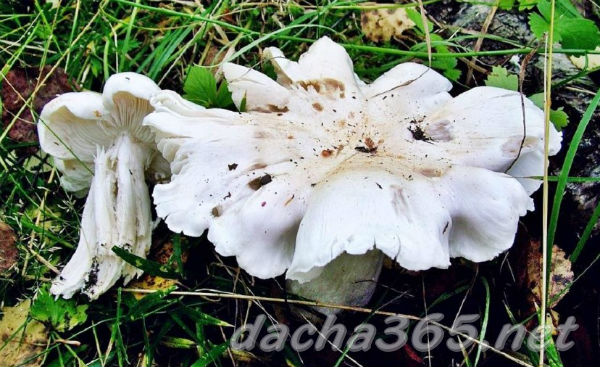
- The cap is dry, smooth, grows in diameter up to 3-10 cm, sometimes up to 15 cm. At first it is hemispherical, as it grows, it becomes convexly open. Its surface is bumpy or strongly wavy, white-cream or ivory. This is the most significant difference of this type of mushroom. There are yellowish spots in the center.
- The leg can be 5-12 cm high, up to 2.5 cm thick. It is dense and elastic, has the shape of a cylinder, slightly narrowed towards the bottom.
- The pulp of the pigeon row is dense and fleshy, as it grows it becomes pink, also turns pink at the break. The smell is mealy, and the taste is pleasant mushroom.
- The plates are attached to the stem, and then free, often located.
- It is an edible mushroom (category 4) and can be boiled and fried.
At the initial stage of growth, the pigeon row is similar to the gray row, also edible, but with a different pleasant aroma. In the process of growth, the changes are more noticeable, due to the gray color of the hat in the gray row.
yellow-red(Tricholomopsis rutilans)
- Large groups are found in mixed or coniferous forests. Prefer rotten pine or spruce stumps and fallen trees.
- Collected from July to September.
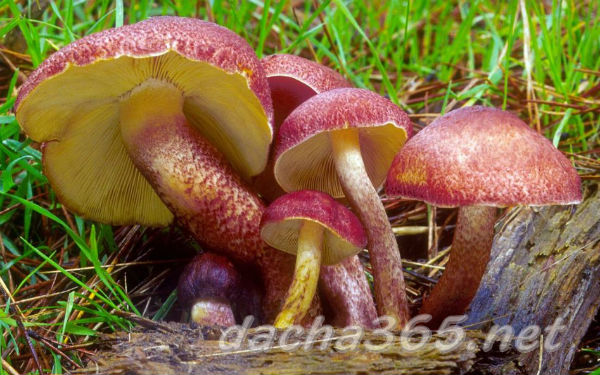
- The hat in diameter can reach 5-15 cm. Initially, it has the shape of a sharp bell-shaped cap. As it grows, it becomes convex with a tubercle in the center, and the edges are bent down. Mature specimens have a prostrate hat, with a slightly depressed middle. The difference of this species is the red-cherry color of the cap in young mushrooms and yellowish-red in more mature ones. Obtuse tubercle, which becomes depressed over time, always of a darker shade.
- The leg reaches 4-10 cm in height, can be up to 2 cm thick. It has a cylindrical shape, with a thickened base, often hollow inside. At the base, the leg is yellow with red scales, the middle part is more intense in color, the rest is the same color as the cap.
- The pulp has a sweetish taste and a slight sour smell. It is dense and fibrous, yellow in color with light cream spores.
- The plates are adherent, thin and sinuous, golden or egg-colored. yellow colors.
- This species is edible, belongs to the 4th category, can be pickled or salted.
Yellow-red rowing is a rare species, in some regions it is listed in the Red Book.
inedible row types
Pseudo white(Tricholoma pseudoalbum)
- It lives singly or in small groups in mixed or deciduous forests.
- Grows from August to October.
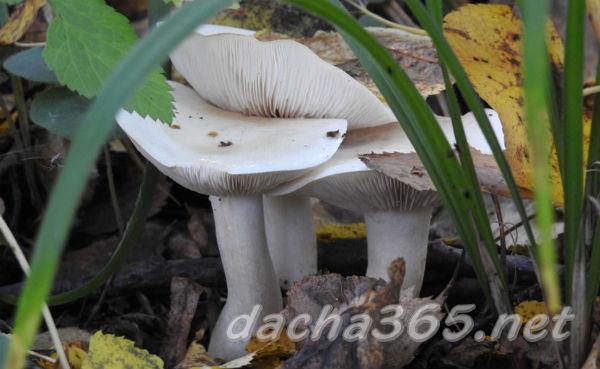
- The hat at the beginning of growth is hemispherical, later becomes convex, reaches a diameter of 3-8 cm. Its color is white, cream or slightly pinkish.
- The leg grows up to 3-9 cm in height and 1.5 cm in width. It is the same shade as the hat: white, pinkish or creamy white.
- The flesh has a powdery smell, at first growth is white, then slightly yellowish.
- Cream-colored plates, at first slightly adherent, and then almost free.
- It has an unpleasant taste, so it is not eaten.
This species is similar in shape and size to the May row (Tricholoma gambosa). But the latter has greenish or pale pink areas on the hat.
smelly(Tricholoma inamoenum)
- Grows in groups or singly in wet areas of deciduous or mixed forests.
- The growing season is from June to October.
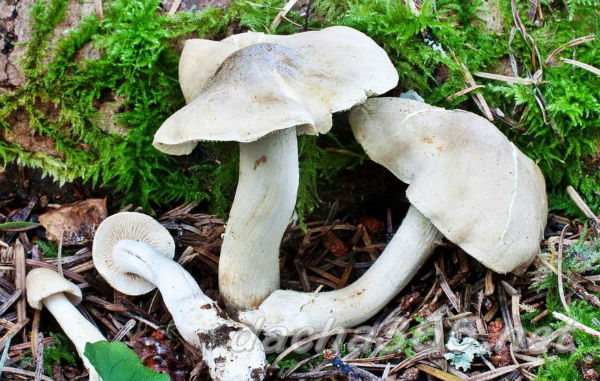
- The cap usually reaches 3-8 cm in diameter, but can grow up to 15 cm. Its surface is smooth, often bumpy, ivory or white, and brownish or yellowish spots appear as it grows. At the beginning of growth, the cap has a hemispherical shape, and with age it becomes convex prostrate, with slightly wavy edges.
- The length of the leg grows up to 5-15 cm, and the thickness is up to 2 cm. It has a cylindrical shape, elastic and dense, the color is identical to the hat.
- The white flesh is fleshy and dense. Representatives of this species are distinguished by a strong smelly smell, which is inherent in both young and old mushrooms. The smell is similar to lighting gas.
- Adherent plates of medium frequency, may be white or cream.
- Because of the stench, these mushrooms are not edible. Even boiling does not eliminate it.
Often at the beginning of growth, you can confuse the smelly row with edible sulfur (Tricholoma portentosum). But it justifies the name and the stinky smell is hard not to notice. And the gray row has a pleasant mushroom aroma.
Beneficial features
Edible rows- a dietary and very useful product. It promotes liver regeneration, has a positive effect on the functioning of the gastrointestinal tract, and removes toxins from the body.
The rich chemical composition of mushrooms:
- from vitamins: group B, A, K, PP, C, D2, D7 and betaine;
- from minerals: sodium, potassium, phosphorus, iron, zinc, manganese;
- from amino acids: threonine, alanine, phenylalanine, lysine, glutamic, stearic and asperganic acids;
- phenols;
- clitocin and fomecin, which are natural antibiotics and fight cancer cells and bacteria;
- flavonoids;
- polysaccharides;
- ergosterol.
Chemical analysis of edible row mushrooms confirms their anti-inflammatory, antiviral, antibacterial, antioxidant properties and a positive effect on immunity.
In addition, in the complex treatment of certain diseases, mushrooms have a positive effect. At:
- diabetes mellitus;
- arrhythmias;
- rheumatism;
- osteoporosis;
- jumps in blood pressure;
- oncological diseases;
- diseases of the genitourinary system;
- diseases of the nervous system.
Harm and contraindications
- Overgrown mushrooms should not be consumed because they can accumulate atmospheric pollution and heavy metals. They will do more harm than good.
- With the abuse of rows, pain, heaviness in the abdomen and flatulence can occur.
- With diseases of the gallbladder, pancreatitis, cholecystitis and diseases of the housing and communal services, a large number of mushrooms of this species should not be eaten.
Symptoms and signs of row poisoning
Symptoms of poisoning with inedible rows, like other poisonous mushrooms, are very similar. They appear 1-3 hours after eating mushrooms:
- pain in the stomach;
- weakness;
- increased salivation;
- vomit;
- diarrhea;
- nausea;
- headache.
Poison rows often do not cause delusions, hallucinations and confusion. But even with the appearance of the first symptoms of this nature, it is necessary to consult a doctor.
- Row mushrooms are considered delicacy species in many countries. Therefore, some of them are grown as export commodities.
- Growing at home resembles mushroom cultivation and is not difficult.
- In cosmetology, powder from the dried fruiting bodies of the fungus is often used. They are added to various products that help fight excessive oily skin and acne.
- The Japanese matsutake mushroom is as highly valued as the European truffle. This fried mushroom is an expensive delicacy, as some specimens can cost as much as $100.
Watch the video! Row white in the forest. How to recognize
In contact with

